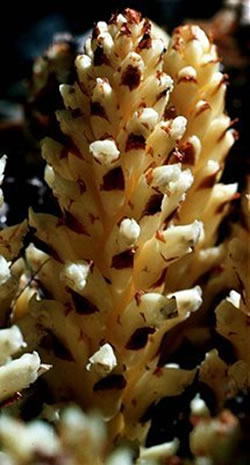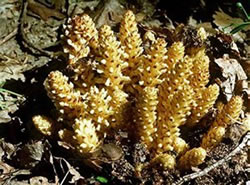Plant of the Week
 Range map of Conopholis americana. States are colored green where the species may be found.
Range map of Conopholis americana. States are colored green where the species may be found.
 Close up of one stem of American cancer-root, showing the resemblance to a pinecone. Photo by Kenneth J. Sytsma.
Close up of one stem of American cancer-root, showing the resemblance to a pinecone. Photo by Kenneth J. Sytsma.
 A clump of American cancer-root in full bloom. Photo by Kenneth J. Sytsma.
A clump of American cancer-root in full bloom. Photo by Kenneth J. Sytsma.
American cancer-root (Conopholis americana (L.) Wallr.)
By Mark Jaunzems
American cancer-root is a fully parasitic plant that occurs only where it can grow attached to the roots of some species of oak (Quercus spp.) (Gleason & Cronquist, 1991). As this plant does not have any chlorophyll it has no green color to it. What little color it does have ranges from cream-colored to yellowish brown when emerging from the ground or fresh and then darker brown shades when the plants are drying out. It is usually found in dense clumps of several erect stems and growing in shady forested sites. It occurs over a wide geographic range in most of the eastern half of the U.S. and Canada. Across its range, it grows on sites that are relatively rich with deep soils and a thick forest canopy where at least some oak trees present. This plant is listed as Threatened in New Hampshire; listed as being of Special Concern in Rhode Island; and considered Exploitably Vulnerable in New York (USDA Plants Database).
American cancer-root stems can grow from 2 to 8 inches (5 to 20 cm) in height and are about ½” to 1” (1.5 to 2.5 cm) in width. This plant is a member of the broom-rape or Orobanchaceae plant family which also has other parasitic plants such as Beech-drops (Ephifagus virginianus) and several species of broom-rape (Orobanche spp.). The scientific name comes from the appearance of the erect stems which have numerous scale like flowers that look a bit like a pinecone, with conos meaning ‘cone’ and pholos meaning ‘scale’ in ancient Greek (Black and Judziewicz, 2008). This dense inflorescence comes to the surface only after the parasite’s root system attaches to the oak root and forms a large woody gall and then builds up enough growth (about four years) (Voss, 1996) After the initial early growth the plant will send up its coniferous looking stems for several years and then die out. The stems usually emerge in the late spring with the small individual flowers opening a few weeks later depending on what part of the plants range is in. This time can wary from quite a bit as this plant has a very wide geographic range from April in Florida to July in Maine and into Canada.
Despite the common name of this plant, there is little or no scientific evidence that it has any cancer prevention or cancer causing properties (USDA Plants Database). The name may simply stem from the parasitic growth form of the plant and the unusual nature of the plant in general. There is some evidence of historical use by Native Americans of a related Mexican species (Conopholis alpina), as an anti-tuberculosis treatment (University of Michigan-Dearborn Herbarium website), but it is not know if this really is an effective treatment or not.
For More Information
- PLANTS Profile - Conopholis americana, American cancer-root
- Black, M. R. and E. J. Judziewicz. 2008. Wildflowers of Wisconsin and the Upper Midwest. Cornerstone Press, Stevens Point, WI, The University of Wisconsin-Stevens Point.
- Gleason, H.A. and A. Cronquist. 1991. Manual of Vascular Plants of the Northeastern United States and Canada, 2nd edition. New York, NY, The New York Botanical Garden.
- Voss, E.G. 1996. Michigan Flora, part III. Cranbrook Institute of Science, Bloomington Hills, MI.
- Native American Ethnobotany Search: Conopholis alpina. University of Michigan-Dearborn, Herbarium website at http://herb.umd.umich.edu/

